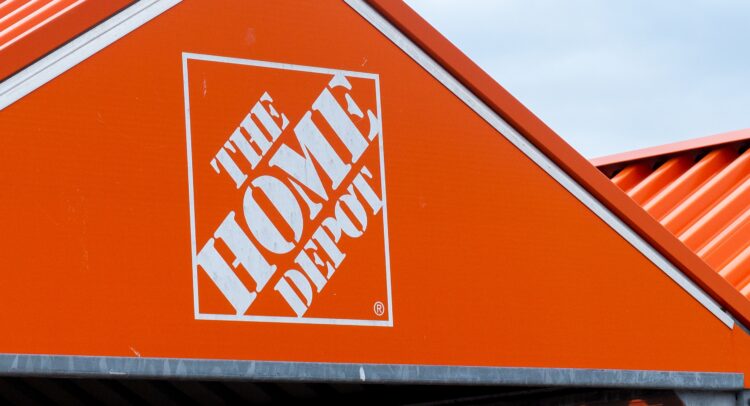Home Depot (NYSE:HD) stock has been on an absolute tear in the last two decades, easily outpacing the broader market in this period. Since March 2004, Home Depot stock has returned 914%, and after adjusting for dividends, cumulative returns are much higher at 1,530%. Comparatively, the S&P 500 Index (SPX) has gained “just” 577% in the past 20 years. Still, as historical returns don’t matter much to current investors, let’s see why HD stock still looks like a top stock to buy.
I am bullish on the stock due to its strong brand recognition, expanding dividends, and robust financials.

An Overview of Home Depot
Valued at $388 billion, Home Depot is a home improvement retailer in the U.S. and other international markets. It sells various building materials, home improvement products, garden products, as well as maintenance and repair products.
Moreover, Home Depot offers installation services for flooring, water heaters, garage doors, central air systems, and much more. It serves homeowners and professionals such as renovators and general contractors.
The company ended 2023 with more than 2,330 retail stores, generating roughly 50% of its sales from individuals and the rest from professionals.
A Focus on the Professional Business Segment
According to Home Depot, professionals or pros account for just 10% of its customer base. However, they visit retail stores much more frequently and have a much higher order value when compared to homeowners. Home Depot already offers a loyalty program for professionals, providing them with specialized perks and business tools to better manage and grow their businesses. Currently, Home Depot has multiple fulfillment options with reliable delivery and value-added offerings for pros.
Last week, the home retail giant disclosed plans to open four new distribution centers in 2024, thereby expanding its pro ecosystem. The new facilities will be located in Detroit, Los Angeles, San Antonio, and Toronto, and this is a key strategy to better serve pro customers.
These distribution centers will stock bulky merchandise such as lumber, insulation, and roofing shingles and should benefit from higher job lot quantities from pros as the products would be delivered directly to job sites.
Home Depot also emphasized that it is working with supply partners to build inventory depth for large pro markets. It has already opened similar pro-focused hubs in the U.S. and aims to end 2025 with a presence in 17 markets.
To expand its pro capabilities, Home Depot recently completed the acquisition of Construction Resources, a leading distributor of appliances and architectural specialty products for pro contracts focused on renovation and remodeling.
A Slowdown in Revenue Growth
Home Depot emerged from the depths of the COVID-19 pandemic as a winner. Its sales rose by 19.9% year-over-year in Fiscal 2020 (ended in January), and top-line growth remained resilient at 14.4% in Fiscal 2021.
However, headwinds such as inflation and rising interest rates acted as headwinds for Home Depot in the last two years, as sales grew by 4% in 2022 and fell by 3% in 2023.
It seems that homeowners are cautious about spending on big-ticket products amid an uncertain macro environment.
Home Depot Has a Growing Dividend
Home Depot is part of a mature industry and generates consistent cash flows across market cycles. In the last decade, its operating margin has consistently topped 12% and is forecast to improve to 14.1% in 2024. Over the years, the company has showcased its ability to operate at scale while investing in the supply chain and expanding omnichannel capabilities, driving earnings and dividends higher.
Home Depot currently pays shareholders an annualized dividend of $9 per share, translating to a forward yield of 2.3%. These payouts have risen by 18.9% annually since 2004, enhancing the effective yield significantly.
The firm has enough room to increase its dividends in the future, as its free cash flow in 2024 totaled $17.9 billion. Comparatively, it paid shareholders total dividends of $8.4 billion, indicating a free cash flow payout ratio of less than 50%. This provides the company with the flexibility to invest in growth projects and acquisitions as well as reduce balance sheet debt.
Investors might be worried about Home Depot’s long-term debt of $44.1 billion. However, in Q4, interest expenses accounted for just 12% of operating income.
Is HD Stock a Buy, According to Analysts?
Out of the 27 analyst ratings given to Home Depot stock, 18 are Buys, seven are Holds, and two are Sells, indicating a Moderate Buy consensus rating. The average Home Depot stock price target is $380, indicating downside potential of 3% from current levels.

Home Depot is forecast to report adjusted earnings of $15.39 per share in Fiscal 2024 and $16.49 per share in Fiscal 2025. So, priced at 25.7x forward earnings, Home Depot stock is expensive, given that the sector median forward earnings multiple is much lower at 16.6x.
The Takeaway
If you can look beyond its slightly lofty valuation, Home Depot looks like a good long-term bet for shareholders despite the lumpiness in its financial results in the last few quarters. The company’s focus on the professional segment should help it improve profit margins due to higher order values and frequency, resulting in inflation-beating returns for shareholders.









